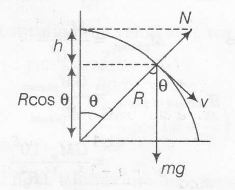Answer:
Option D
Explanation:

h= R -Rcos Ω
Using conservation energy
$mgR(1-\cos\theta)=\frac{1}{2}mv^{2}$
Radial force equation is
$mg\cos\theta-N=\frac{1}{R}mv^{2}$
= mg ( 3$\cos\theta$-2)
Here, $N=mg \cos\theta-\frac{mv^{2}}{R}$
N= 0 at $\cos\theta=\frac{2}{3}$
$\Rightarrow$ Normal force act radially outward on bead if cos θ >2/3 and normal force act radially inward on bead if
cos θ < 2/3
$\therefore$ Force ring is opposite to normal force on bead.